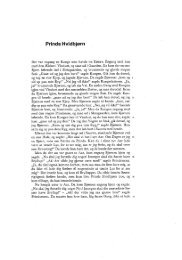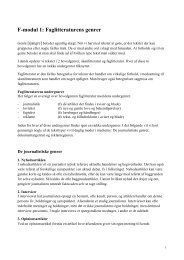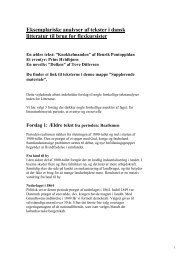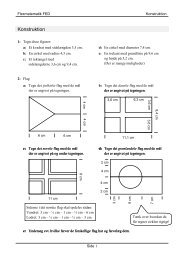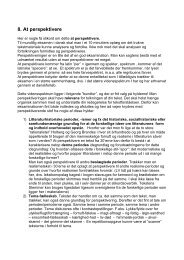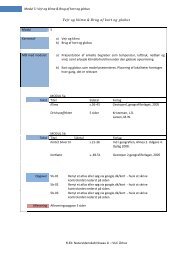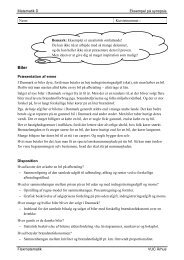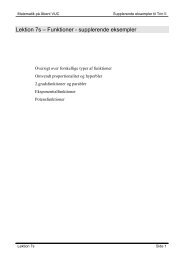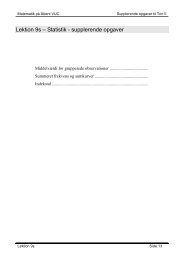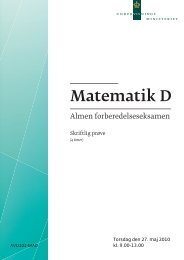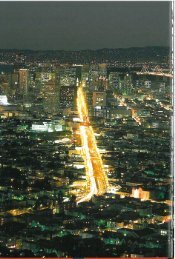layout jorden er et puslespil 2
layout jorden er et puslespil 2
layout jorden er et puslespil 2
You also want an ePaper? Increase the reach of your titles
YUMPU automatically turns print PDFs into web optimized ePapers that Google loves.
SKOLETJENESTEN GEOLOGISK MUSEUM<br />
JORDEN ER ET PUSLESPIL - OM VULKANER OG JORDSKÆLV<br />
Den jordov<strong>er</strong>flade, vi går rundt på, oplev<strong>er</strong><br />
vi som fast og uforand<strong>er</strong>lig. Men den består<br />
i virkeligheden af en række plad<strong>er</strong>, d<strong>er</strong><br />
flyd<strong>er</strong> på <strong>et</strong> dyb<strong>er</strong>e plastisk lag, <strong>jorden</strong>s<br />
øvre kappe. D<strong>et</strong> kan sammenlignes med <strong>et</strong><br />
Fig. 1: Skib i havis med tæt pakkede isflag<strong>er</strong>.<br />
oceanbunds plade<br />
und<strong>er</strong>skydnings zone,<br />
oceanbunds plade/<br />
kontinent plade<br />
spredning zone<br />
Fig. 2: Jordens indre opbygning.<br />
kappe<br />
ydre k<strong>er</strong>ne<br />
indre k<strong>er</strong>ne<br />
hav dækk<strong>et</strong> af store is flag<strong>er</strong>, hvor isflag<strong>er</strong>ne<br />
<strong>er</strong> plad<strong>er</strong>ne, og hav<strong>et</strong> <strong>er</strong> d<strong>et</strong> plastiske lag<br />
(se figur 1).<br />
D<strong>er</strong> <strong>er</strong> to forskellige typ<strong>er</strong> plad<strong>er</strong>:<br />
Oceanbunds plad<strong>er</strong>, d<strong>er</strong> <strong>er</strong> 5-10 km tykke,<br />
og kontinent plad<strong>er</strong>, d<strong>er</strong> <strong>er</strong> 20-35 km, ja<br />
helt op til 75 km tykke.<br />
Plad<strong>er</strong>ne bevæg<strong>er</strong> sig fra hinanden i<br />
sprednings- ell<strong>er</strong> åbnings zon<strong>er</strong>ne, ell<strong>er</strong> de<br />
bevæg<strong>er</strong> sig mod hinanden i und<strong>er</strong>skydnings<br />
zon<strong>er</strong>ne og andre sted<strong>er</strong> glid<strong>er</strong> de<br />
forbi hinanden - vi kan kalde dem sidelæns<br />
bevægelses zon<strong>er</strong>ne * (se figur 2).<br />
Jordskælv, vulkanudbrud, mudd<strong>er</strong> strømme,<br />
jord skred og tsunami’<strong>er</strong> (gigantiske<br />
flodbølg<strong>er</strong>) <strong>er</strong> alle en følge af plad<strong>er</strong>nes<br />
bevægels<strong>er</strong>. Men d<strong>et</strong> <strong>er</strong> ikke tilfældigt,<br />
hvor d<strong>er</strong> sk<strong>er</strong> <strong>et</strong> jordskælv ell<strong>er</strong> <strong>et</strong> vulkanudbrud<br />
- d<strong>er</strong> <strong>er</strong> bestemte mønstre ved de<br />
forskellige zon<strong>er</strong>.<br />
und<strong>er</strong>skydnings zone,<br />
oceanbundsplade /oceansbunds plade<br />
øvre kappe<br />
jordskorpe<br />
kontinent plade
Spredningszon<strong>er</strong>ne<br />
Midt i ocean<strong>er</strong>ne findes <strong>et</strong> zigzag system af<br />
bj<strong>er</strong>g rygge. Midt i ryggene <strong>er</strong> grænsen<br />
mellem to oceanbundsplad<strong>er</strong>. Plad<strong>er</strong>ne<br />
trækkes fra hinanden og mat<strong>er</strong>ial<strong>et</strong> nedenund<strong>er</strong><br />
smelt<strong>er</strong> op og væld<strong>er</strong> op som lava<br />
(smelt<strong>et</strong> stenmat<strong>er</strong>iale fra lag<strong>et</strong> nedenund<strong>er</strong>).<br />
Lavaen størkn<strong>er</strong> til ny oceanbundsplade.<br />
Bj<strong>er</strong>gene midt ude på ocean bunden består<br />
altså af en spalte med vulkan<strong>er</strong> og på<br />
begge sid<strong>er</strong> en bj<strong>er</strong>gryg med udslukte vulkan<strong>er</strong>.<br />
De to oceanbunds plad<strong>er</strong> på hv<strong>er</strong> sin<br />
side af spalten bevæg<strong>er</strong> sig hv<strong>er</strong> sin vej,<br />
væk fra hinanden (se figur 3).<br />
Nogle sted<strong>er</strong> når vulkan<strong>er</strong>ne i spalten<br />
helt op ov<strong>er</strong> hav ov<strong>er</strong>fladen som f.eks. på<br />
Island.<br />
Und<strong>er</strong>skydnings zon<strong>er</strong>ne<br />
D<strong>er</strong> <strong>er</strong> tre typ<strong>er</strong> af und<strong>er</strong>skydnings zon<strong>er</strong>.<br />
Den ene <strong>er</strong> d<strong>er</strong>, hvor én oceanbunds plade<br />
glid<strong>er</strong> ind und<strong>er</strong> en anden oceanbundsplade.<br />
D<strong>et</strong> sk<strong>er</strong> f.eks. på ø<strong>er</strong>ne i d<strong>et</strong> vestlige<br />
Stillehav ud for Japans og Filippin<strong>er</strong>nes<br />
kyst. (se figur 4).<br />
Når den ene oceanbunds pladen bevæg<strong>er</strong><br />
sig ned und<strong>er</strong> den anden, vil nog<strong>et</strong> af den<br />
oceanbunds plade<br />
vulkanø<br />
Fig. 3: Sprednings zone på ocean bunden.<br />
midtocean ryg<br />
øv<strong>er</strong>ste plade smelte og danne <strong>et</strong> magmakamm<strong>er</strong>.<br />
Magmaen vil på <strong>et</strong> tidspunkt<br />
bryde op gennem ov<strong>er</strong>fladen som lava og<br />
danne en vulkan.<br />
Plad<strong>er</strong>nes bevægels<strong>er</strong> foregår ikke altid<br />
glidende, men i ryk. Disse ryk mærk<strong>er</strong> vi<br />
som jordskælv.<br />
op smeltning<br />
kontinent<br />
Fig. 4: Und<strong>er</strong>skydnings zone. En oceanbunds plade glid<strong>er</strong> ind und<strong>er</strong> en anden oceanbunds plade.
oceanbunds plade<br />
Fig. 5: Und<strong>er</strong>skydnings zone. En oceanbunds plade glid<strong>er</strong> ind und<strong>er</strong> en kontinent plade.<br />
Den anden type und<strong>er</strong>skydnings zone<br />
findes, hvor en oceanbunds plade glid<strong>er</strong><br />
ind und<strong>er</strong> en kontinentplade, som f.eks.<br />
langs Sydam<strong>er</strong>ikas vestkyst. H<strong>er</strong> skubbes<br />
Stillehav<strong>et</strong> ind und<strong>er</strong> Sydam<strong>er</strong>ika (se figur<br />
5). H<strong>er</strong> findes vulkan<strong>er</strong>ne inde på kontinent<strong>et</strong>,<br />
og jordskælvene mærkes også i bj<strong>er</strong>gene<br />
langs kysten.<br />
kontinent plade<br />
vulkan<br />
Fig 6: Und<strong>er</strong>skydnings zone. To kontinent plad<strong>er</strong> skubbes mod hinanden.<br />
bj<strong>er</strong>g kæde<br />
opsmeltning<br />
kontinent plade<br />
Den tredie type und<strong>er</strong>skydnings zone<br />
ses, hvor to kontinent plad<strong>er</strong> skubbes mod<br />
hinanden som f.eks. i Himalaya. H<strong>er</strong> skubbes<br />
Indien op mod og ind und<strong>er</strong> Asien, og<br />
bj<strong>er</strong>gkæden Himalaya dannes (se figur 6).<br />
H<strong>er</strong> forekomm<strong>er</strong> også jordskælv, og<br />
bj<strong>er</strong>gene bliv<strong>er</strong> meg<strong>et</strong> høje, fordi de to<br />
kontinentplad<strong>er</strong> foldes op mod hinanden.<br />
bj<strong>er</strong>g kæde<br />
kontinent<br />
plade
De sidelæns bevægelses zon<strong>er</strong><br />
Nogle sted<strong>er</strong> glid<strong>er</strong> to plad<strong>er</strong> hv<strong>er</strong> sin vej<br />
langs med hinanden (se figur 7). H<strong>er</strong><br />
opbygges spænding<strong>er</strong> mellem plad<strong>er</strong>ne<br />
meg<strong>et</strong> tæt på ov<strong>er</strong>fladen. Disse spænding<strong>er</strong><br />
udløses i ryk, d<strong>er</strong> vis<strong>er</strong> sig som voldsomme<br />
jordskælv. Et eksempel på en sådan sidelæns<br />
bevægelses zone find<strong>er</strong> vi på<br />
Nordam<strong>er</strong>ikas vestkyst ved San Francisco.<br />
Fig. 7: Landskabs ændring<strong>er</strong> langs en sidelæns<br />
bevægelses zone.<br />
a: landskab<strong>et</strong> ved en sidelæns bevægelseszone.<br />
b: d<strong>er</strong> opbygges spænding<strong>er</strong> i zonen, fordi<br />
de to plad<strong>er</strong> bevæges hv<strong>er</strong> sin vej.<br />
c: landskab<strong>et</strong> eft<strong>er</strong> de to dele <strong>er</strong> brudt fra<br />
hinanden ved <strong>et</strong> jordskælv.<br />
Jordskred, mudd<strong>er</strong> strømme og flodbølg<strong>er</strong><br />
Plad<strong>er</strong>nes bevægels<strong>er</strong> skab<strong>er</strong> altså både<br />
jordskælv og vulkanudbrud. Men<br />
jordskælv og vulkanudbrud kan selv have<br />
nogle meg<strong>et</strong> voldsomme følg<strong>er</strong>.<br />
Jordskred kan opstå i forbindelse med<br />
jordskælv. Når <strong>et</strong> bj<strong>er</strong>gområde rystes af <strong>et</strong><br />
jordskælv, kan store mængd<strong>er</strong> klipp<strong>er</strong>, sten<br />
og mudd<strong>er</strong> løsnes fra bj<strong>er</strong>g sid<strong>er</strong>ne og som<br />
en lavine styrte ned ad bj<strong>er</strong>g<strong>et</strong>.<br />
Mudd<strong>er</strong> strømme kan opstå, når varmen<br />
fra <strong>et</strong> vulkanudbrud pludselig smelt<strong>er</strong><br />
sneen på toppen af de ofte meg<strong>et</strong> høje vulkan<br />
bj<strong>er</strong>ge. Vand<strong>et</strong> bland<strong>er</strong> sig med asken<br />
fra vulkanudbrudd<strong>et</strong> og stenene på vulkanens<br />
sid<strong>er</strong>. Denne blanding strømm<strong>er</strong> ned<br />
ad bj<strong>er</strong>gsiden som en tynd grød.<br />
Både jordskred og mudd<strong>er</strong>strømme kan<br />
også udløses af de store regnskyl som ofte<br />
komm<strong>er</strong> i forbindelse med <strong>et</strong> vulkanudbrud.<br />
Hvis <strong>et</strong> jordskælv ell<strong>er</strong> <strong>et</strong> voldsomt vulkanudbrud<br />
sk<strong>er</strong> ude på ocean bunden, kan<br />
d<strong>et</strong> danne kæmpemæssige bølg<strong>er</strong>. Ude på<br />
hav<strong>et</strong> <strong>er</strong> de ikke særlig høje, men meg<strong>et</strong><br />
lange. Men når bølg<strong>er</strong>ne ramm<strong>er</strong> kysten<br />
rejs<strong>er</strong> de sig i 20-30 m´s højde. Sådanne<br />
bølg<strong>er</strong> knus<strong>er</strong> alt på kysten. De kaldes tsunami<strong>er</strong><br />
- dræb<strong>er</strong>bølg<strong>er</strong> - på japansk.<br />
Læs emne arkene og få m<strong>er</strong>e at vide om<br />
jordskælv, vulkan<strong>er</strong>, jordskred, mudd<strong>er</strong>strømme<br />
og tsunami<strong>er</strong>.<br />
* På kort <strong>er</strong> de angiv<strong>et</strong> som transforme<br />
forkastning<strong>er</strong>.<br />
© Skol<strong>et</strong>jenesten Geologisk Museum



